
California's Infamous Stage Robber
BLACK BART THE LEGEND ENDS
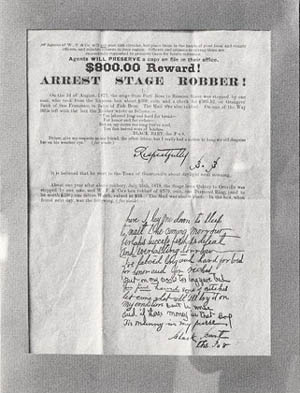
Reward Poster for Black Bart $800
Photo courtesy Calaveras County Historical Society.
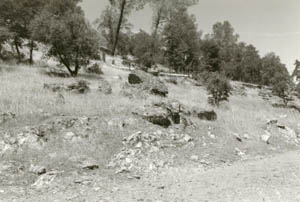
Actual robbery site at Funk Hill
Photo courtesy Calaveras County Historical Society.
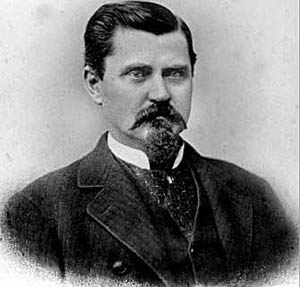
Reason McConnell
Wells Fargo Stage Driver
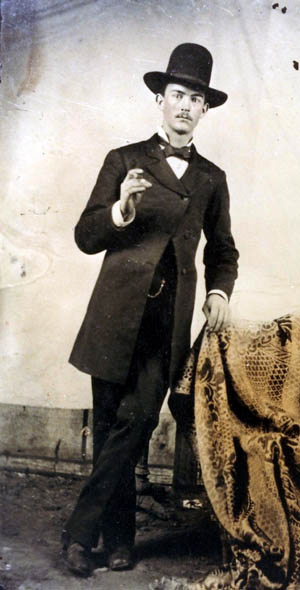
Jimmy Rolleri
Photo courtesy Calaveras County Historical Society.
Wells Fargo presented Jimmy with a Model 73 Winchester "One of One Hundred" rifle. The rifle blew apart the first time he fired it. Then Wells Fargo the gave Jimmy a second rifle. Unfortunately, it was just a standard Winchester, not a "One of One Hundred". Jimmy died in 1903 at 37 years old.
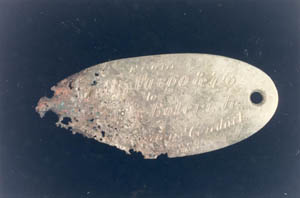
Jimmy Rolleri's Rifle Tag
Photo courtesy Calaveras County Historical Society.
Jimmy's rifle was put on display, by his sister, at the Calaveras Hotel in Angels Camp, California. The hotel and rifle were destroyed in a fire in 1938. This tag is all that remains. The tag reads: James Rolleri, Jr., For meritorious Conduct, November 3, 1883.

Henry Wells
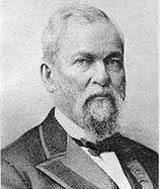
William G. Fargo
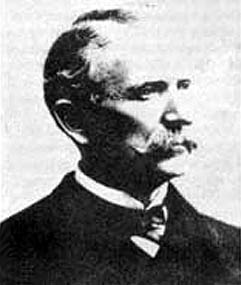
Wells Fargo Detective James Hume
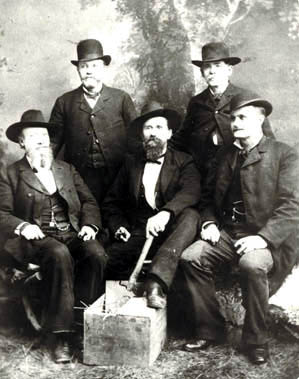
They Caught Bart
Photo courtesy Calaveras County Historical Society.
The men who helped hunt down Black Bart. Seated (L to R) San JoaQuin County Sheriff Tom Cunningham, Calaveras County Sheriff Ben Thorn (holding hatchet), Wells Fargo agent Harry Morse. Standing (L) San Francisco Police Captain A.W. Stone. Standing (R) J.W. Thacker Wells Fargo Special Agent. Photo taken in 1883.
It was early morning when 31 year old stage driver, Reason E. McConnell (Mac to his friends) pulled up to Reynolds Ferry Hotel on the Stanislaus River. He had been to the Patterson Mine near Tuttletown and picked up 228 ounces-nineteen pounds-of amalgamated gold worth $4,200. Also in the Wells Fargo strong box was $550 in gold coins and $64 in raw gold. For security, the strong box had been bolted to the floor of the coach for the trip between Sonora and Milton. 19-year-old Jimmy Rolleri came out of the hotel, run by his mother Olivia, and gave Mac a bundle of mail. Mac had previously told Jimmy he had seen a lot of deer in the mountains on these early morning runs. Jimmy said he couldn't go hunting because he didn't have any ammunition. Mac had told Jimmy he would buy him some ammunition and bring it on his next run, Mac had the ammunition with him this morning. Jimmy thought that the storm the previous night may have driven deer down from the high country so he wanted to ride along with Mac to do some deer hunting. Mac agreed. Jimmy got his well-worn .44 Henry rifle, some money to pay Mac for the ammunition, and climbed aboard the Mud Wagon. Mac started the four horse team off toward Funk Hill.
The coach was half-way up Funk Hill when Jimmy Rolleri said to McConnell, "I'll get off here and work my way around the hill." Jimmy jumped off the coach to start hunting and McConnell continued up the hill. McConnell was rounding the head of Yaqui Gulch, close to the top of the ridge, when a hooded figure with a shotgun jumped out in front of him. It was Black Bart.
Note: There are many versions of what happened next. We have read all the different versions and have concluded from what was said by Reason McConnell at the time, Wells Fargo reports and later information, that this is the most accurate version that we can determine.
Bart was jittery because he saw Jimmy get off the stage, as he had been watching the whole time. He asked McConnell where the man went that jumped off. McConnell quickly replied it was a kid looking for stray cattle. Bart told McConnell to throw down the the strong box. McConnell said he couldn't because it was bolted to the floorboards. Bart told McConnell to get down off the stage and unhitch the horses. McConnell said the brakes on the stage wouldn't hold if he got down and the coach would roll down the hill. Bart said, "It won't roll down the hill if you put rocks behind the wheels." McConnell said, "Why don't you do it?" The robber told him "Get down from there and do it quick." McConnell knew the robber was clearly getting agitated, and he meant business, so McConnell took no more chances and followed orders. He got down and put a rock under the wheel and started to unhitch the horses, all while having a shotgun squarely aimed at him. McConnell was leaving, leading the horses up the hill, when Bart started hammering away at the strong box with his hatchet. McConnell stopped to catch his breath at the top of the ridge, about two hundred yards from the coach. He could not see the robber but he could hear him hammering and prying on the metal box. McConnell caught sight of Jimmy coming around the hill, still hunting. He knew with Jimmy's gun they could capture or kill the outlaw. He waved and got Jimmy's attention and signalled him to come around out of the robbers sight. Jimmy thought McConnell had sighted a deer. Mac quickly explained to Jimmy the situation and they started toward the coach. They were about 100 yards away when Bart, having finally broken into the strong box, jumped out of the coach and spotted Jimmy and Mac. McConnell1, who had taken the rifle from Jimmy, fired at Bart twice as he started to run away. He missed. Jimmy, however, being a very good shot said, "Here, give it here, I won't miss." Jimmy took the rifle and fired just as Bart was entering a thicket. They saw him stumble as the bullet found its mark. Running to where they had last seen the robber, they found a bundle of mail he had dropped, and scattered further on was more mail that had blood on it. McConnell then hitched the team back up, picked-up the broken treasure box and the tools that Bart had used to break into the box, and put them in the coach. McConnell then continued on to Copperopolis and reported the robbery. A posse comprised of Well Fargo agent W.H. Case, Billy Fagan, Milton Curry and Jimmy Rolleri went back out to the site. They searched the site for evidence and eventully found the vital evidence that was the undoing of Bart. Found: a travel worn leather valise containing a case for a pair of field glasses, a belt, a razor, three soiled linen shirt cuffs2, two paper sacks containing crackers and sugar, and two empty flour sacks. Also in the bag was an old handkerchief in which was knotted a handful of buckshot. Before nightfall Calaveras County Sheriff Ben Thorn had reached the scene and began a search for additional evidence. That night they returned to Copperopolis with Wells Fargo Agent Case having custody of the evidence they found. Wells Fargo Chief Detective James Hume had been notified and was on his way as was Special Agent John Thacker3. Joaquin County Sheriff Tom Cunningham and Tuolumne County Sheriff George McQuade had been asked to watch out for Black Bart.
Days later in a meeting in Mr Case's office the importance of the dirty white silky handkerchief became clear when the laundry mark was noted in the corner. Black Bart's days were numbered. But, the meaning or purpose of the buckshot is unknown.
It took Bart about half an hour to break into the Wells Fargo strong box. He said by the time he had it open he was so exhausted that a ten-year-old boy could have captured him. When Bart got out of the stage, he had to start running because McConnell started shooting at him. He was so tired, and carrying that heavy sack weighting nearly 20 pounds, Bart could only run at a dog-trot. After running about a quarter of a mile he stopped, too tired to run any farther. His hand hurt and was bleeding heavily. He wrapped a handkerchief around the wound to help stop the bleeding. Bart found a rotten log and stuffed the sack with the gold amalgam into it. He kept the $500 in gold coins. Bart buried the shotgun in a hollow tree but threw away everything else except what he needed to get by. At one cabin along his escape route he stole a hat to replace his derby. Bart tried to avoid people but on Monday, near Bear Mountain, he accidentally stumbled into "Old Martin" the hunters cabin. He asked for false directions and was on his way. On Tuesday he arrived in Sacramento, having travelled almost 100 miles through the rough California mountains. Bart went to the barber shop and got a shave and a hair cut. Then he went to one of the better tailors and got measured for a suit of clothes, bought a ticket for the train to Reno, wandered around town for a while, then caught the train to Reno. He wrote two letters, one to his landlady saying he would be back in a few days and to hold his lodgings and one to his laundryman, Thomas Ware, to hold his laundry. He stayed in Reno a few days and then returned to Sacramento to pick up his clothes. On Saturday he returned to San Francisco and slept at the City-Front Lodging-House that night. The next day when it appeared that everything was normal, he returned to his residence at the Webb House and went back to his usual habits and enjoying the good life.
"Wells Fargo Never Forgets"
Since its beginnings in
1853 Wells Fargo had taken pride in the safe delivery of gold and other
express. It had relentlessly tracked down other desperadoes who had
dared to rob treasure entrusted to the company. And now this single
individual with his outlandish costume and annoying little poems was
making a shambles of this proud tradition. Bart even had the audacity
to tell more than one stage driver during a holdup, " Please give
my regards to Detective Hume." Now things were about to change.
When Hume received the evidence from Sheriff Thorn, he turned it over to
Harry Morse4, who had been hired by Hume for the specific purpose of
tracking down Black Bart. They agreed that the handkerchief with the
"F.X.O.7.5" laundry mark was their best clue. But, where to
start? Being as they were in San Francisco, they would start here. A
check of city records revealed there were 91 laundries in the city.
Morse knew he had a job in front of him, so he started going from
laundry to laundry looking for a match to the laundry mark. After about a
week, on Monday, November 12, Morse was at the Biggs California Laundry,
at 113 Stevenson Street. The owner, Phineas Ferguson, recognized the mark
and sent Morse to the tobacco shop of one of the company agents, Thomas
C. Ware, at 316 Post Street. Tobacco shops in the 1880's were sort of
early-day convenience stores. Ware said the washing belonged to C.E.
Bolton a friend of his. Bolton was a mining man who often visited his
mines. Sometimes he would be gone for a week or two, sometimes for as
long as a month. Morse introduced himself as Harry Hamilton and said he
too was involved in mining and would like to meet Bolton. Ware said
that Bolton had just dropped off some laundry and would be around again the
next morning. Morse also found out that Bolton lived at Webb House, No.
37 Second Street, room 40. Morse placed a watch on the house to keep an
eye to see if any person went in or out. Morse returned to the laundry
office to talk to Ware. Ware said, "Why, there comes Bolton now,
I'll introduce you to him." Morse knew immediately from the
description they had from people who had seen a stranger after the
robbery that he had his man. Bolton was elegantly dressed, carrying a
little cane. He wore a natty little derby hat, a diamond pin, a large
diamond ring on his little finger and a heavy gold watch and chain. He
was 5 feet 8 inches in height with deep sunken bright blue eyes, straight
as an arrow, broad shouldered,
high cheek bones and a large handsome
grey moustache and imperial; the rest of his face was clean shaven. One
would have taken him for a gentleman who had made a fortune and was
enjoying it. Morse introduced himself as Hamilton and asked if Bolton was the
mining man? Bolton said, "Yes I am." Morse then told Bolton he
had a matter of importance relating to some mines that he wished to
consult with him about. Could he spare a few moments? Bolton said,
"Certainly." They walked down Bush to Montgomery Street,
then to California and Sansome just like a couple of businessmen, right
up to the door of Wells Fargo and Company's office. When Charles Bolton
entered the office he seemed undisturbed. Morse requested to be seated
and then the long awaited introduction was made to James B. Hume.
Hume said he just wanted to have a little talk with him and commenced
by inquiring about his business. Where were his mines located? On being
closely pressed, Bolton was unable to give either the name of the mine or
its exact location. Bolton began to get a little excited and great
drops of perspiration stood out on his forehead and nose. He said,
"I am a gentleman and I don't know who you are. I want to know
what this inquiry is about? "Hume said he would tell him if Bolton
would answer his questions. Morse noticed a piece of skin knocked off
Bolton's right hand and brought it to the attention of Hume. Bolton
said he struck it when getting off a train car at Truckee. Bolton was
asked a great number of questions that he could not or would not
answer. The interview had gone on for over three hours and Bolton
finally grew indignant and said he was a gentleman and refused to
answer any more questions.
Hume called Captain Stone of City Prison, and along with Hume and
Bolton they went to Bolton's room at Webb House. In his room they found a
large trunk, two valises, three or four suits of clothes, and among them a
suit answering the description of those worn by the man who robbed the
stage near Copperopolis. In one of he pockets they found a handkerchief bearing the
same laundry mark as the one found at the scene of the robbery. In the
trunk were a lot of cuffs and collars and shirts all with the same
laundry mark. On being asked about the mark Bolton said, "I am not
the only one whose things bear that mark. Others have their
washing done at the same place. Somebody may have stolen the
handkerchief from me, or I may have lost it and someone else found
it." Bolton usually spoke with calmness and a pleasant smile.
"Do you take me for a stage robber? I never harmed anybody in all
my life, and this is the first time that my character has ever been
called into question." Also found in Bolton's room was a Bible.
The inscription read, "This precious Bible is presented to
Charles E. Boles, First Sergeant Company B, 116th Illinois Volunteer
Infantry, by his wife as a New Year's gift, God gives us hearts to
which His -- faith to believe. Decatur, Illinois, 1865." It was
signed by Mary Boles.
The next morning at 7:30 AM Captain Stone and Detective Hume took
Charles Bolton and started out for Stockton. They telegraphed Sheriff
Thorn to get Thomas P. Martin, "Old Martin" the hunter, to
identify the stranger he saw after the robbery that had been committed
by Black Bart. As soon as he saw Bolton he said, "That's the man,
that's him!" Even now as the evidence piled up Bart did not show
concern. He still joked and was amused that the huge crowd outside the
jail thought that he was one of the officers and one of them was the
prisoner. They took Bolton to Reason McConnell to see if he could
identify him. When McConnell took the shot at Bart, he was at least 100 yards
away, and up close he was wearing a mask. But when the two talked,
McConnell told Morse that this was definitely the man that had robbed
him. After many more hours of questioning Bart realized that things
were not going his way. Bart asked Morse, "I don't admit that I
committed this robbery, but what benefit would it be to the man who
did, to acknowledge it?" Morse was excited, Bart was showing the
first signs of weakening. Morse said, "If a stage robber forced
his accusers to take him to trial and he was found guilty of several
robberies, a judge might well give him a maximum sentence." Morse
continued, "On the other hand, if a stage robber pleaded guilty to a
single crime with which he was charged, then went on to make
restitution, that probably would be taken into consideration by the
judge." Bart asked Morse, "Suppose the man that did commit the
robbery should do this, would it not be possible for him to get
clear altogether?" To his credit Morse did not lie. "No. The
law does not look upon stage robbery lightly. A man who pleads guilty
to robbery must expect a prison sentence. However, that would
certainly be better than a trial and the possibility of spending the
rest of his life behind bars." Bart stood up, it was cool in the
jail but there were beads of sweat on his forehead. Bart said, "I
want you to understand that I'm not going to San Quentin, I'll die
first." The interview went on for a little longer, always with the
benefits of confession and restitution and the fear Bart had of a
lengthy prison sentence. Then Morse called in Sheriff Thorn and Captain
Stone. Bart had decided that he would take his chances with confession
and restitution for the Funk Hill robbery. Then Bart said, "Let's
us go after it." Thirty minutes later Morse, Stone and Black Bart
were headed to Funk Hill to recover the stolen gold.
On November 16, 1883, in the Justice Court of Judge P.H. Kean in San
Andreas, Charles E. Bolton entered a plea of "guilty" to the
single charge of having robbed the Sonora-Milton stage on Funk Hill on
November 3, 1883. He was bound over to the Calaveras County Superior
Court for trial. The following day, November 17, 1883, after waiving
jury trial, Bolton pleaded guilty to the same robbery charge before
Superior Judge C.V. Gottschalk. Judge Gottschalk sentenced Charles E.
Bolton to six years in San Quentin Prison. On Wednesday, November 21,
1883, he began serving his sentence at San Quentin.
In court Bart always denied that he was either Black Bart or Charles E.
Boles. The prison records at San Quentin list him as Charles E. Bolton.
However, during his incarceration, and after, he wrote many letters to his wife,
Mary Boles. Many have speculated that Bart used the Bolton name in prison
so as not to embarrass and draw attention to his family.
From a San Quentin form: Charles Bolton's markings:
Reg. No. 11046...Small mole left cheek bone, scar right top forehead,
scar inside left wrist, Fat. shield Right upper Arm. (tattoo). Gunshot
wounds right abdomen. High cheek bones, heavy eye brows. Head: large
& long. Forearms hairy & tuft of hair on breast. Prom. Nose and
Broad at Base."
1 In a recently discovered journal written by Reason McConnell some 20 years after the Black Bart hold-up, McConnell says that he fired all the shots at Black Bart and that Jimmy Rolleri did not fire the gun. However, at the time of the robbery, McConnell did not dispute the fact that Rolleri fired the shot that wounded Bart. And he did not say anything when Wells Fargo awarded Rolleri the Winchester Rifle. But, there is speculation that may validate McConnell's claim when you question the reason why Rolleri never received any of the reward money.
2 Harry Morse and other accouts say that the laundry mark, F.X.O.7., was on the shirt cuffs but John Thacker said it was actually was on a hankerchief found with all the other items.
3 Some historians say that Sheriff Thorn discovered the laundry mark, but it has been refuted and the laundry mark is said to have been discovered by John Thacker.
4 When George Baker was a teenager he was a shotgun guard on the wagons that carried gold from the trains to the mint in San Francisco. He didn't know Harry Morse personally, but all the employees shared the same lunchroom and people often met the detective there to hear him re-tell the story of capturing the outlaw Black Bart. Everyone could hear Morse relate the adventure. He said the laundry mark that led to Bart's capture was on a shirt cuff, there was no mention of a handkerchief. This story was told by George Baker to his family.
5 There is some dispute over what the laundry mark actually was. Sheriff Thorn said it was F.X.O.7., all in caps. John Thacker said it was F.O.X.7. Harry Morse twice said it was F.O.K.7. and he was most familiar with the laundry mark on the handkerchief. Boles said in a letter that the mark was Fox7, but he was far-sighted and the K could have looked like an X to him. Thomas Ware, the tobacconist/laundry agent, never did say what the laundry mark was.
Home | Why Bart | Legend Begins | C.E. Boles | Legend Ends | Prison | Robberies | Family Tree | Trivia | Plaque | ????
Want to contact us? E-mail the Webmaster